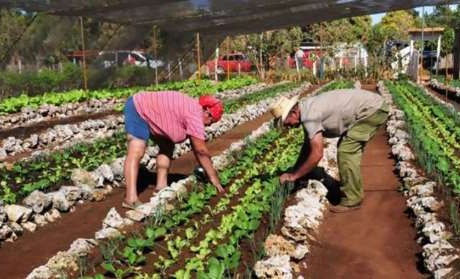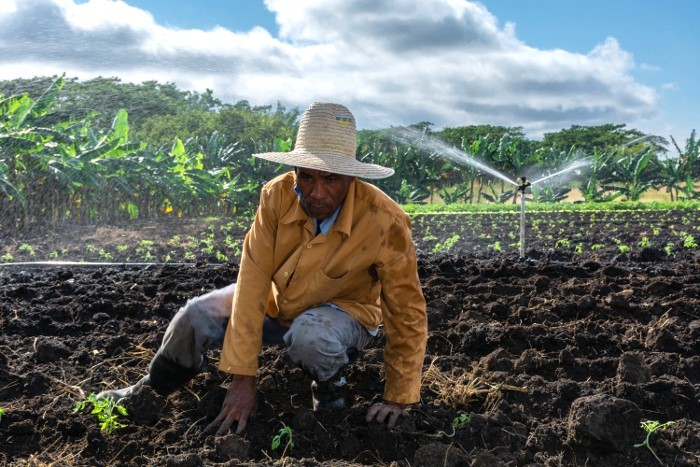Thoughts about Cuba’s Agricultural Development
Thanks to the imposition of state socialism, Cuba has gone from “excess production” to grave food scarcity.
This article derives from a much lengthier chapter, to be published in "Desafiando el control: Políticas alimentarias de Cuba y Venezuela", ed. Claudia González Marrero y Nastassja Rojas (Editorial 4métrica, 2024), who have authorized this short article. The statistical data and all the notes pertinent to this text appear in detail in that chapter.
“We must ask ourselves, therefore: “Why are recurring economic errors repeated yet again?” That was President Miguel Díaz-Canel’s question in April 2022 as he pondered Cuba’s economic crisis, inviting us to attempt to explain the reappearance of the same failed policy, notwithstanding the country’s persisting food challenges.
The ideas that have framed agricultural policy and commercialization stem from one source. Despite the changes in shadings over the years, key elements of Cuba’s state socialism have retained these features:
- Privilege state farms and those cooperatives for which the state determines what should be produced, with what inputs and at what prices.
- Compel priority cultivation of certain products to be sold to the state purchasing board at fixed national prices (adjusted from time to time) – all products were subject through 1975 and the greater proportion of production in subsequent years.
- Ration consumer purchases by means of the official rationing card, although at times , the existence of the ration card did not guarantee product availability.
- Prohibit private merchants from trading in these specified agricultural products.
- Limit the ability of private sector farmers from hiring workers.
This article assesses the consequence of the application of these ideas through an empirical analysis of five episodes in the country’s history: the initial agricultural policies in 1959 and the early 1960s; the 1968 Revolutionary Offensive; the Rectification, which started in 1986; the Special Period during the 1990s; and the economic counterreform of 2015-2019.
The circumstances in those episodes differ greatly. For example, agricultural sugar production predominated during the early episodes, but not in the current century. Private property predominated during the first episode but not in the others, during which its importance diminished but also varied.
Gross domestic product rose before the first and third episodes, but it fell in the current century. The international situation varied; combat occurred with the United States from the start, but with a slight reconciliation during Barack Obama’s presidency; and the alliance with the Soviet Union collapsed in the 1990s. Similarly, the political regime’s features evolved – revolutionary- mobilization in the 1960s, but not in the current century.
The only variable that reappears in each of the five episodes is the prevalence of state socialism, which is applied regardless of the results and the other factors at play. That is, the other variables, important as they may be at specific junctures, cannot serve as general explanations, as they are not present in all of the five periods considered. However, this ideological factor – this state socialism – does appear in every period, producing similar recurrent consequences: a crisis.
The explicative arc is the same in each episode, notwithstanding the wide differences among them. In general, each starts with an “excessive” production success in the agricultural private sector that, according to leadership of the Communist Party of Cuba, violates the permissible limits of its official ideology.
Therefore, the state responds each time by adopting policies derived from the ideological framework, which provide familiar and comfortable options, strengthen the power of decision makers, and are applied notwithstanding the changed empirical contexts. This ideologically rooted policy generates counterproductive results because each time production decreases and a food crisis emerges.
The Five Episodes
Start of the 1960s. At the beginning of 1959, the end of the civil war, and the production incentive incorporated in the 1959 Agrarian Reform Law, led to a spurt in the rural private sector’s agricultural production. State socialists considered those private producers to be their enemies, thereby expropriating the lands of the more successful ones in 1963.
Similarly, state socialism undermined the cooperatives established by the first agrarian reform law in order to transform them into state farms. It deemed market-based trade in agricultural goods to be unacceptable, imposed price controls, and subjected the farmers to state supervision. Production contracted sharply, which, along with the adverse impact of U.S. economic sanctions, led to a food crisis and the establishment of consumer goods rationing in 1962, a policy that persists today despite variations.
Thanks to the imposition of state socialism, Cuba transited from the “excess” of agricultural production to a severe food scarcity crisis.
The Revolutionary Offensive (1968). Between 1964 and 1967, there was a modest increase in agricultural production that, according to the official government view, was excessive. The so-called Revolutionary Offensive, launched in 1968, interrupted it. In 1967, the government-sponsored National Association of Small-plot Agriculturalists committed to ensure that all farmers s would sell their output exclusively to the state purchasing board.
In response to farmers aiming to sell products at better prices than those paid by the state purchasing board, the government imposed national fixed prices and monopolized output purchases. The state also expropriated small private vendors, the majority of whom were directly involved in the purchase and sale of food and served as a key link for feeding people in the cities. From the productive success of the mid 1960s, Cuba transited to political and ideological imposition over farm production and, once again, it generated a food crisis.
Rectification (1986-1989). In 1980, free farmers’ markets were authorized. Producers could sell their output excess once they met their commitments to the state purchasing board. Until 1975 farmers were prohibited from selling in private markets, while in 1980 these new markets opened in specific locations to trade in agricultural products at prices set by supply and demand.

During the first half of the 1980s, agricultural production jumped markedly. It was another instance of “too much success”, however. In 1986, the government closed the free farmers’ markets and announced a new policy, known as the Rectification of Errors and Negative Tendencies: farmers seeking to sell at a better price, the government claimed, corrupted them.
Under Cuba’s state socialism, agricultural trade had to occur through the state purchasing board and at the prices it sets. The outcome of the Rectification policy worsened agricultural production. Therefore, this “excessive” farm productive success, which occurred while farmers could set their prices, turned out to be unacceptable, too, thereby generating a new food crisis on the eve of the collapse of European communist regimes.
The Special Period (the 1990s). The collapse of the Soviet Union ensured the collapse of Cuba’s economy; in particular, agricultural output plunged. The Communist Party’s Fourth Congress, held in 1991, insisted in continuing Rectification policies and, especially, in centralizing decision making as much as possible.
The food crisis became acute, impeding the effectiveness of partial reforms that sought to create new types of agricultural cooperatives. The state insisted that it had to guide, determine and centralize all decisions regarding what these cooperatives had to produce, to whom they could sell, at what prices, with which inputs, and with what potential investments.
The state defined the supply, quantity, and marketing for the projected new cooperative production, at low prices that in many instances failed to pay for production costs.
Agricultural producers remained obligated to sell the majority of their products to the state purchasing board. A food catastrophe followed, featuring severe nutritional deficiencies, the reappearance of instances of hunger, street protests, and an emigration burst.
In the summer of 1994, protests broke out in Havana. General Raúl Castro intervened, leading to the authorization of the so-called agricultural markets, which nonetheless remained subject to price controls.
The Counterreform (2015-2019). The worldwide economic crisis that broke out in 2008-2009 affected Cuba. It stimulated a program of economic reforms known as the Lineamientos (guidelines), authorized in 2011. There was then some acceleration of economic growth rates, but the deficient application of the reforms prevented the country from achieving better macroeconomic results.
However, under these modest reforms, food production increased in the private agricultural sector, which fed most of the population. Its “excessive” success once again resulted in punishment. A new official counter reform followed, capping the prices that could be charged by the private sector, requiring greater adherence to the state purchasing board, and worsening the national food crisis on the eve of the COVID-19 pandemic.
Conclusions
“Why are the recurring economic errors repeated yet again?”, asked President Díaz-Canel in 2022. These five historical episodes over six decades are markedly different in many respects, except on how, within each episode, food policy evolved.
Despite noteworthy variations in land tenure, the relative importance of sugar agriculture, the rise or fall of the gross domestic product, the international situation, and some evolution of the national political regime, repeatedly, under state socialism, the results of food policies worsened outcomes. When the agricultural private sector showed productive achievements over the years, state socialist ideology imposed a return to official socialist rule.
In April 2024, at a meeting to assess the production outcomes in the provinces, there was a review of the lack of fulfillment of food and nutritional policies. In shock and amazement, Cuba’s Vice-President Salvador Valdés Mesa responded to the report: “people have gotten used not to be under contract and then they take their products to the best buyer, to the one that pays them the most.” To fix this horror of selling products to whomever pays more, he proposed “control and discipline” measures. The same recurring errors are repeated one more time.
State socialist ideology inspires policies that are attractive for official decision makers. These policies are familiar, easy for them to rely on, and justify their exercise of political power. They provide clear rules for action, making it possible to blame the bad results on other causes and people, especially and always on “imperialism and the U.S. blockade.” Thus, these failed policies appear and reappear, and they generate bad food policy outcomes, again and again.

Jorge I. Domínguez. The author, already retired, was a professor of political science at Harvard University (1972-2018). Access to his web page is free, https://jorgeidominguez.com where his publications are available in Spanish and English.

